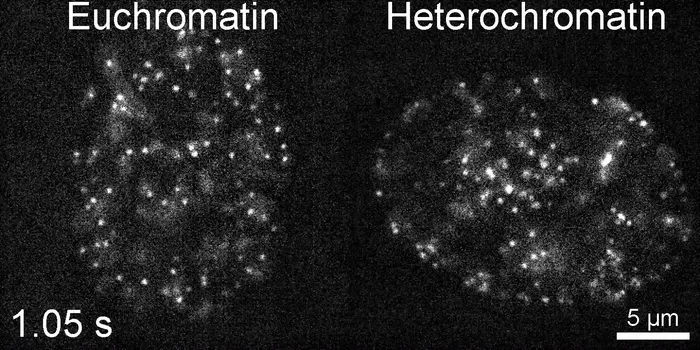A groundbreaking study conducted by a Japanese research team has shed light on the intricate dynamics of chromatin within living human cells. Chromatin, the complex of DNA and proteins that packages genetic material, plays a crucial role in gene expression and cellular function. The researchers, led by Professor Kazuhiro Maeshima from the National Institute of Genetics (ROIS) and SOKENDAI, have pioneered an innovative technique known as "Repli-Histo labeling," enabling them to visualize two distinct forms of chromatin—euchromatin and heterochromatin—in real time. Their findings, published in the esteemed journal Science Advances, provide valuable insights into the physical properties of these chromatin types and deepen our understanding of gene regulation.
Inside each human cell, approximately two meters of DNA is meticulously organized within a minuscule nucleus. The DNA is wrapped around histone proteins to form chromatin, which exists in two primary structural states: euchromatin and heterochromatin. Euchromatin, associated with actively expressed genes, is characterized by a more open and dynamic configuration, while heterochromatin, where transcription is suppressed, adopts a denser, more rigid structure. Understanding how these two forms of chromatin interact and organize themselves within the cell is fundamental to deciphering the regulatory mechanisms of gene expression.
Despite the critical role of chromatin in cellular activity, the organization and behavior of euchromatin and heterochromatin within living cells have remained elusive until now. Katsuhiko Minami, the first author of the study, emphasized that the ability to specifically label and distinguish between these two chromatin types in living cells represents a significant advancement in molecular biology. This gap in understanding has impeded scientists’ efforts to fully comprehend how chromatin dynamics influence gene regulation and cellular functions.
The innovative Repli-Histo labeling technique employs a combination of newly developed fluorescent markers that target specific chromatin regions, allowing researchers to visualize the movements and interactions of euchromatin and heterochromatin in real time. The study revealed stark differences between the two forms: euchromatin exhibited greater flexibility and dynamism, while heterochromatin was found to be more static and rigid. This profound distinction suggests that euchromatin resembles a liquid state, promoting the movement of proteins and other molecules, thus facilitating their interaction with genes.
Conversely, heterochromatin functions more like a gel, creating a barrier that hinders molecular access. The implications of these findings are profound, as they suggest that the physical characteristics of chromatin can significantly influence cellular processes such as gene expression and DNA replication. The researchers propose that understanding the differential behavior of euchromatin and heterochromatin could lead to breakthroughs in comprehending how genes are accessed and utilized by the cell, ultimately impacting gene regulation and function.
Kako Nakazato, a co-author of the study, noted that the differences in chromatin behavior are vital for understanding the orchestration of gene activation and repression. If chromatin is either excessively rigid or overly flexible, it can lead to dysfunction in gene activity—potentially contributing to a variety of cellular disorders. This study challenges the traditional view of chromatin as a static entity and presents it instead as a dynamic structure, continuously engaged in regulating gene function and cellular processes.
The researchers are optimistic about the future applications of Repli-Histo labeling, as they plan to develop a comprehensive chromatin behavior atlas. This atlas aims to map out how various factors, including epigenetic modifications, affect the movement and dynamics of chromatin within the nucleus. By creating this resource, they hope to gain deeper insights into the complex interplay between chromatin behavior and gene regulation.
Understanding the management of genomic information within the confined space of the nucleus is a monumental task. According to Professor Maeshima, the ultimate goal of this research is to elucidate how the cell efficiently handles the vast amount of DNA packed inside its nucleus. This understanding has far-reaching implications, not only for normal cellular function but also for unraveling the complexities associated with diseases, including cancer.
In summary, the striking revelations from this innovative study conducted by the National Institute of Genetics represent a pivotal advancement in the field of molecular biology. As scientists continue to explore the dynamic behavior of chromatin, it may pave the way for novel therapeutic strategies targeting gene regulation and cellular health. The implications of these findings extend beyond basic research, providing a foundation for future studies aimed at addressing critical health issues linked to chromatin dysfunction.
Through advancements such as Repli-Histo labeling, researchers may finally begin to tackle the age-old mystery of how chromatin structure and dynamics contribute to gene expression and the regulation of life’s essential processes. This study not only enhances our understanding of chromatin but also opens new avenues for exploring the molecular underpinnings of health and disease.
As this research continues to evolve, scientists will keep seeking answers to the many questions that arise regarding chromatin behavior. The journey through the intricacies of genetic information management inside a living cell is just beginning, and as our tools for visualization and analysis improve, so too will our comprehension of the fundamental principles governing life itself.
Subject of Research: Chromatin dynamics and gene regulation
Article Title: Unlocking the Mysteries of Chromatin Dynamics: Visualizing Euchromatin and Heterochromatin in Living Cells
News Publication Date: March 28, 2023
Web References: Science Advances
References: Not specified
Image Credits: Katsuhiko Minami & Kazuhiro Maeshima, National Institute of Genetics, ROIS
Keywords: Chromatin, euchromatin, heterochromatin, gene regulation, molecular biology, Repli-Histo labeling, visualizing chromatin, gene expression, DNA packaging, cancer research.




